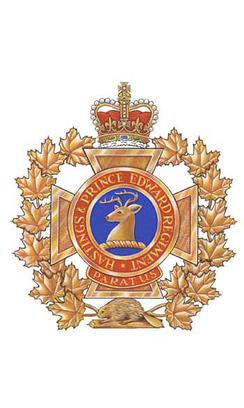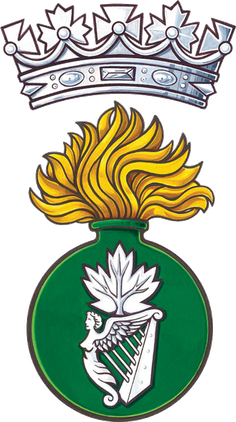Related Research Articles

The Hastings and Prince Edward Regiment is a Primary Reserve infantry regiment of the Canadian Army. The regiment is part of 33 Canadian Brigade Group, one of four brigade groups of 4th Canadian Division. The regimental headquarters and one company are located at 187 Pinnacle Street in Belleville, with additional companies in Peterborough and Cobourg. The Peterborough Armoury houses what was traditionally B Company or Moro Company, and C Company or Cassino Company is housed in an industrial mall unit on Willmott Street in Cobourg. Normally, the regiment deploys as a composite, Ortona Company, while the headquarters and administration form Somme Company.
The Prince Albert Volunteers (PAV) is the name of two historical infantry units headquartered in Prince Albert, Saskatchewan. The unit was first raised in 1885 during the North-West Rebellion and disbanded after hostilities ceased. In the 20th century, the unit was operational from 1913 to 1936 and 1941 to 1946. The PAV is now incorporated by amalgamation in the North Saskatchewan Regiment (N Sask R).

The 2nd/10th Dragoons was a militia regiment of the Canadian Army, based in the Niagara, Wentworth, and Brant regions of southern Ontario. It was formed in 1936 by amalgamating the 2nd and 10th Dragoons, both of which had served previously as cavalry units in the Canadian militia. After World War II the regiment was converted into an anti-aircraft artillery unit. In 1962 the regiment was converted into a field howitzer unit and in 1968 amid a downsizing of the Canadian Armed Forces the regiment was reduced drastically before eventually being completely disbanded in the mid-1990s. The regiment is currently on the Supplementary Order of Battle.
The 15th Canadian Light Horse was a light cavalry regiment of the Non-Permanent Active Militia of the Canadian Militia. First formed in 1905 as the 15th Light Horse, the regiment was redesignated in 1920 as the 15th Canadian Light Horse. In 1936, the regiment was Amalgamated with The South Alberta Horse to form the 15th Alberta Light Horse.
The 10th Brant Dragoons was a cavalry regiment of the Non-Permanent Active Militia of the Canadian Militia. First raised in 1909 as the 25th Brant Dragoons, the regiment was redesignated in 1921 as the 10th Brant Dragoons. In 1936, the regiment was amalgamated with the 2nd Dragoons to form the 2nd/10th Dragoons – now part of the 57th Field Artillery Regiment, RCA.

The Irish Fusiliers of Canada (The Vancouver Regiment) was an infantry regiment of the Canadian Army. It was placed on the Supplementary Order of Battle in 1965. In 2002, it was taken off the Supplementary Order of Battle and amalgamated with The British Columbia Regiment (Duke of Connaught's Own).
The Saskatoon Light Infantry was an infantry regiment of the Non-Permanent Active Militia of the Canadian Militia. The regiment was formed in 1924, when The North Saskatchewan Regiment (1920–1924) was reorganized into four separate regiments. In 1955, the regiment was amalgamated with The Prince Albert and Battleford Volunteers to form The North Saskatchewan Regiment.
The Eastern Townships Mounted Rifles was a cavalry regiment of the Non-Permanent Active Militia of the Canadian Militia. In 1936, the regiment was converted from cavalry to artillery and became the 27th Field Artillery Regiment, Royal Canadian Artillery.
The King's Canadian Hussars were a cavalry regiment of the Non-Permanent Active Militia of the Canadian Militia. In August 1939, the regiment was converted to artillery and currently exists today as the 87th Field Battery, RCA.
The New Brunswick Dragoons was a cavalry regiment of the Non-Permanent Active Militia of the Canadian Militia. In 1936, the regiment was Amalgamated with The Saint John Fusiliers.
The Manitoba Horse was a cavalry regiment of the Non-Permanent Active Militia of the Canadian Militia. First formed in 1912 as the 32nd Light Horse, the regiment was redesignated later that same year as the 32nd Manitoba Horse and again in 1920 as The Manitoba Horse. In 1936, the regiment was amalgamated with The Fort Garry Horse.
The Manitoba Mounted Rifles was a cavalry regiment of the Non-Permanent Active Militia of the Canadian Militia and later the Canadian Army. In 1946, the regiment was converted to artillery.
The British Columbia Hussars was a light cavalry regiment of the Non-Permanent Active Militia of the Canadian Militia. In 1939, the regiment was converted from light armour to artillery.
The Victoria and Haliburton Regiment was an infantry regiment of the Non-Permanent Active Militia of the Canadian Militia. In 1936, the regiment was Converted from Infantry to Artillery to become the 45th Field Battery RCA and now forms part of the 50th Field Artillery Regiment, RCA.
The Dufferin and Haldimand Rifles of Canada was an infantry regiment of the Non-Permanent Active Militia of the Canadian Militia and later the Canadian Army. The regiment was formed in 1936, when The Haldimand Rifles was Amalgamated with The Dufferin Rifles of Canada. In 1946, the regiment was converted from Infantry to Artillery and now forms part of the 56th Field Artillery Regiment, RCA.
The Argyll Light Infantry was an infantry regiment of the Non-Permanent Active Militia of the Canadian Militia. In 1936, the regiment was converted from infantry to form one of the Canadian Army's first tank units, and then in 1946 was converted to anti-tank artillery. In 1954, the regiment was converted back to infantry and amalgamated along with The Midland Regiment into The Hastings and Prince Edward Regiment.
The 10th Field Artillery Regiment, RCA is an artillery regiment of the Canadian Army Primary Reserve. Based in Regina, Saskatchewan, the regiment forms part of the 38 Canadian Brigade Group of the 3rd Canadian Division.
The North Saskatchewan Regiment was a short-lived infantry regiment of the Non-Permanent Active Militia of the Canadian Militia. In 1924, the regiment was reorganized and split up into 4 separate regiments.
The Saskatchewan Mounted Rifles was a cavalry regiment of the Non-Permanent Active Militia of the Canadian Militia. First formed in 1908 as the Saskatchewan Light Horse, the regiment was later redesignated that year as the 22nd Saskatchewan Light Horse and again in 1920 as The Saskatchewan Mounted Rifles. In 1911, the regiment transferred two of its squadrons to the newly formed 29th Light Horse. In 1936, the regiment was amalgamated with the 16th Canadian Light Horse to form the 16th/22nd Saskatchewan Horse.
The 16th Canadian Light Horse was a light cavalry regiment of the Non-Permanent Active Militia of the Canadian Militia. First formed in 1905 as the 16th Mounted Rifles, the regiment was Redesignated in 1908 as the 16th Light Horse and again in 1920 as the 16th Canadian Light Horse. In 1936, the regiment was amalgamated with The Saskatchewan Mounted Rifles to form the 16th/22nd Saskatchewan Horse.
References
- 1 2 3 4 "Guide to Sources Relating to the Canadian Militia (Infantry, Cavalry, Armored)" (PDF). Library and Archives Canada . Archived (PDF) from the original on 2015-04-02.
- 1 2 3 4 5 Defence, National (2019-01-28). "10th Field Artillery Regiment, RCA". www.canada.ca. Retrieved 2022-01-09.
- 1 2 3 "18th Canadian Light Horse". 2007-09-11. Archived from the original on 11 September 2007. Retrieved 2022-01-09.
- ↑ Luscombe, Stephen. "Canadian Cavalry". www.britishempire.co.uk. Retrieved 2022-01-09.
- ↑ "Otter Committee". www.canadiansoldiers.com. Retrieved 2022-01-09.
- ↑ "1936 Reorganization of the Militia". www.canadiansoldiers.com. Retrieved 2022-01-09.
- ↑ "The Minute Book". www.regimentalrogue.com. Retrieved 2022-01-09.
- ↑ "Guide to Sources Relating to the Canadian Militia (Artillery)" (PDF). p. 866. Retrieved 2022-08-03.
- ↑ "Canadian Western Cavalry 1903–1914". MilArt. 2015-08-29. Retrieved 2022-01-09.
- ↑ Defence, National (2019-07-22). "WWI - Ypres, 1915". www.canada.ca. Retrieved 2022-01-09.
- ↑ Defence, National (2019-07-22). "WWI - Festubert, 1915". www.canada.ca. Retrieved 2022-01-09.